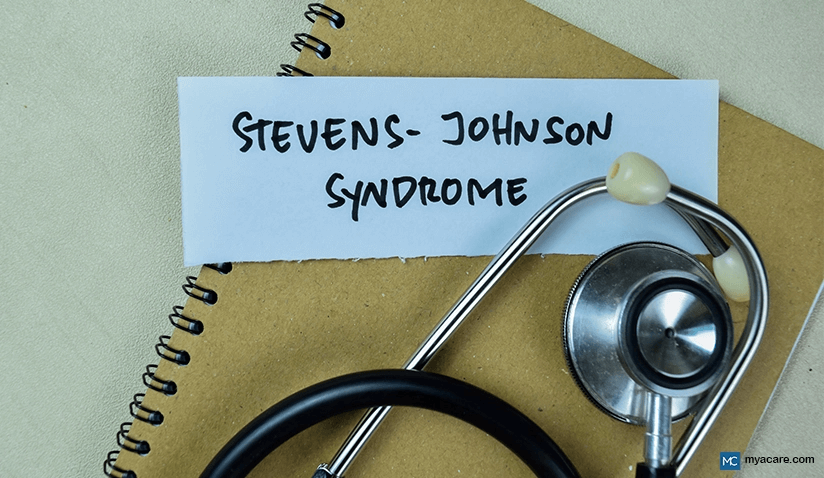Could Your Medication Cause Stevens-Johnson Syndrome? What You Need to Know

Medically Reviewed by Dr. Rae Osborn, Ph.D. - July 04, 2024
Stevens-Johnson syndrome (SJS) is an uncommon yet serious disorder affecting the skin and mucous membranes. It is an emergency with potentially life-threatening consequences that requires immediate medical attention.
This article will explore SJS, its causes and triggers, symptoms, treatment, and prevention.
What is Stevens-Johnson Syndrome?
Stevens-Johnson syndrome (SJS) is a severe skin disorder that causes large amounts of skin to blister and peel off. It is a type of hypersensitivity reaction that certain medications, infections, or other factors can trigger. Toxic Epidermal Necrolysis (TEN) is a more severe form of SJS, affecting more than 30% of the skin. TEN is a medical emergency and can be life-threatening.
SJS is a rare condition, with an estimated prevalence of 1-5 cases per million people per year. The risk may be higher for individuals with a weakened immune system, a history of SJS, and other factors.
The severity of Stevens-Johnson Syndrome (SJS) directly impacts survival rates. People with a larger area of affected skin tend to have a higher risk of death. Adults with SJS (less than 10% body surface area involvement) have a mortality rate around 5%, while those with Toxic Epidermal Necrolysis (more than 30% involvement) can face a mortality rate as high as 30%. Children with SJS generally have a better prognosis, with death rates ranging from 0% to 17%. For a more precise prediction of individual survival chances, doctors can use a scoring system called SCORTEN upon admission.[1].
Causes and Triggers of Stevens-Johnson Syndrome
The exact cause of SJS has yet to be fully understood. It is thought to be an immune-mediated reaction. Adverse drug reactions are accountable for up to 80% of cases.[2].
After reviewing findings, researchers theorize that those with SJS may fail to clear reactive by-products after ingesting medication. The by-products may trigger a highly explosive immune reaction in the skin. Specific immune cells, called CD8+ T lymphocytes, have been found alongside high quantities of inflammatory cytokines (immune chemicals) in the skin blisters of those with the condition.
Infections and other factors can trigger SJS in the remaining 20% of susceptible individuals.
Medications that may cause SJS
Over 200 medications can cause SJS. Here are a few examples:
- Antibiotics
- Anticonvulsants
- Nonsteroidal anti-inflammatory drugs (NSAIDs)
- Allopurinol (used to treat gout)
- Antiretroviral drugs
- Chemotherapy drugs
It is noteworthy that not all who ingest these medications will develop SJS.
Certain genetic factors have been identified that may make individuals more susceptible to developing SJS when exposed to these medications. These factors are medication-specific and suggest that those with autoimmune genetic variations are more susceptible, such as HLA variations in response to anticonvulsants.
Other Triggers
Other factors that can trigger an SJS reaction include:
- Infections (such as herpes, influenza, and pneumonia)
- Vaccinations
- Exposure to radiation
- Systemic lupus erythematosus (SLE)
Symptoms of Stevens-Johnson Syndrome
SJS usually starts with flu-like symptoms, including a fever, fatigue, and a sore throat. These take 1-3 weeks to develop after taking an offending medication. This stage is followed 1-4 days later by a painful rash that can quickly spread and cover large body areas.
The rash may appear as red or purple spots, blisters, welts, or patches of skin that look burned. Unlike allergic reactions or sunburn, SJS is a reaction with potentially life-threatening consequences that require immediate medical attention.
This reaction pulls and weakens the skin, causing it to shed relatively large amounts. The amount of skin shed varies depending on the classification:
- Stevens-Johnson syndrome affects under 10% of the body's surface area.
- Overlap of Stevens-Johnson Syndrome/Toxic Epidermal Necrolysis affects 10% to 30% of the body’s surface area.
- Toxic epidermal necrolysis involves over 30% of the body's surface area.
Other symptoms may include:
- Painful blisters in the mouth, nose, eyes, and genitals
- Swelling of the face and tongue
- Red, water eyes
- Hives
- Skin shedding and scabbing
- Affected nails and eyebrows
- Breathing difficulties due to shedding in the lining of the lungs
Some symptoms of SJS are systemic, leading to generalized autoimmune signs in other areas of the body. These include joint pain, vision problems, fatigue, weight loss, nausea, vomiting, and loss of appetite.
Long-term Effects and Complications
SJS can lead to long-term effects, even after the initial symptoms have resolved. These effects may include:[3].
- Scarring of the skin and mucous membranes
- Changes in skin pigmentation
- Dry eyes and vision problems
- Dehydration and difficulty swallowing
- Profuse chronic sweating
- Lung damage leading to obstructive pulmonary disease and asthma
- Kidney damage
- Arthritis
- Chronic fatigue and pain
- Loss of hair or nails
- Urinary issues or pain
- Changes in taste perception
- Sepsis
Above these physical effects, SJS can have a profound emotional and psychological impact, causing significant distress, anxiety, and depression in individuals who experience it. The physical pain, long-term effects, and changes in appearance associated with SJS can have a detrimental influence on self-esteem, body image, and overall quality of life.
Support from healthcare professionals, family, and friends is crucial to aid those affected in coping.
Risk Factors for Stevens-Johnson Syndrome
Anyone can develop SJS using certain medications, as mentioned above. The following factors raise the risk of acquiring SJS in response to drugs, including:[4]
- Age and Gender: SJS is slightly more common in adults over 40, especially women.[5]
- Genetics: Autoimmune genetic factors, such as those associated with the HLA (human leucocyte antigen) may make some individuals more susceptible. A family history may also increase the odds of acquiring SJS.
- History of SJS: Having SJS in the past increases the risk of developing it again.
- Weakened immune system: Conditions such as cancer, or HIV substantially increase the risk.
Can I ever take the medication that caused SJS again?
If you reacted to a medication in the past, there is a much higher chance it will occur again in the future. Those with SJS should avoid medications that cause the reaction at all costs.
Diagnosis of Stevens-Johnson Syndrome
SJS is diagnosed based on a physical examination, medical history, and skin biopsy. SJS patients also typically have skin sloughing and pain, which will be noted in an exam. A skin biopsy involves examining a small sample of skin tissue under a microscope. This can assist in confirming the diagnosis and rule out other conditions.
A medical professional may opt for the following medical examinations to rule out other causes and factor in aspects that may change the course of treatment. These include:[6]
- A complete blood count tests for anemia and assesses immune cell levels.
- Liver function tests to check liver markers and albumin levels.
- Kidney function tests to determine kidney filtration, blood sodium, and creatinine levels.
- Pulmonary function tests, including a bronchoscopy or chest x-ray, to look for shedding of lung bronchial mucosa or tissue abnormalities.
- Cardiac function tests to identify abnormal results on the electrocardiogram (ECG) and imaging.
Treatment of Stevens-Johnson Syndrome
SJS is a medical emergency and requires immediate treatment. The main aim is to stop disease progression and manage symptoms.
In severe cases, hospitalization may be necessary, and patients may require treatment in a burn unit.
Treatment may include:[7]
- Stopping the use of any medications that may be causing SJS
- Supportive care (such as pain management, fluid replacement, electrolyte replacement, tube feeding, and wound care)
- Consulting dermatologists or ophthalmologists (if the eyes are impacted)
- Non-reactive antibiotics to prevent infections
During recent years, research has highlighted a few new treatment options. However, they are still under debate:[8]
- Corticosteroids, TNF-alpha inhibitors, and cyclosporine to reduce inflammation and suppress immune function
- Intravenous immunoglobulin (IVIG) to boost the immune system
- Plasmapheresis (a procedure that removes harmful antibodies from the blood)
Combinations of these treatments may yield better results. Research is ongoing to confirm the actual benefits of these treatments.
The recovery time for SJS can vary depending on the severity and the individual's overall health. In mild cases, the skin may heal within a few weeks, yet it may take several months for the skin to recover fully. In more severe cases, the recovery time may be longer, and some individuals may have long-term effects.
Life with Stevens-Johnson Syndrome
Life with SJS can be challenging, both physically and emotionally. The initial reaction can cause substantial pain and discomfort, and the long-term effects can impact daily life. It is essential to seek support from healthcare professionals, family, and friends to manage the physical and emotional impacts of SJS.
Prevention of Stevens-Johnson Syndrome
There is no guaranteed way to prevent SJS. Still, some steps can be taken to reduce the risk, such as:[9]
- Avoiding medications that have been linked to SJS (if possible)
- Being aware of the symptoms of SJS and seeking medical attention if they occur
- Informing healthcare professionals of any history of SJS or allergies to medications
- Wearing a medical ID accessory such as a bracelet that explains your medication sensitivity. Keep it on permanently.
- Taking medications as directed and not stopping or changing them without consulting a doctor
- Seeking medical attention if any symptoms of SJS occur after starting a new medication
Research Advances in Stevens-Johnson Syndrome
Research is ongoing to better understand the causes and triggers of SJS and to develop more effective treatments. A few active research areas include:
- Pinpointing genetic factors that increase SJS susceptibility
- Better genetic screening methods for predicting susceptibility in response to medication[10]
- Developing new treatments to stop the progression of SJS
- Studying the long-term effects of SJS and how to manage them
- Investigating the role of the immune system in SJS
Progress on SJS is slow and emphasizes the complexity of associated genetics and the reaction involved in causing the condition.
Takeaways
Stevens-Johnson syndrome is a rare yet severe skin disorder that certain medications, infections, or other factors can trigger. It constitutes a medical emergency that requires urgent treatment. The reaction can have long-term effects and can impact daily life. By understanding the causes, triggers, and treatment, those vulnerable can reduce their odds of acquiring this life-threatening condition.
To search for the best health providers for dermatology in Croatia, Germany, Greece, Italy, Malaysia, Singapore, Slovakia Spain, Thailand, The UAE, the UK, and the US, please use our free search engine.
To search for the best doctors and healthcare providers worldwide, please use the Mya Care search engine.
The Mya Care Editorial Team comprises medical doctors and qualified professionals with a background in healthcare, dedicated to delivering trustworthy, evidence-based health content.
Our team draws on authoritative sources, including systematic reviews published in top-tier medical journals, the latest academic and professional books by renowned experts, and official guidelines from authoritative global health organizations. This rigorous process ensures every article reflects current medical standards and is regularly updated to include the latest healthcare insights.

Dr. Rae Osborn has a Ph.D. in Biology from the University of Texas at Arlington. She was a tenured Associate Professor of Biology at Northwestern State University, where she taught many courses to Pre-nursing and Pre-medical students. She has written extensively on medical conditions and healthy lifestyle topics, including nutrition. She is from South Africa but lived and taught in the United States for 18 years.
Sources:
Featured Blogs



